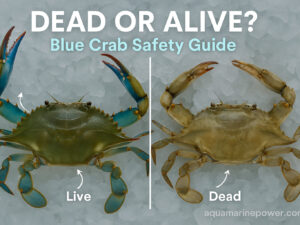When choosing crab meat at the seafood counter, understanding the difference between lump and white grades can save you money and improve your dishes. Lump crab meat comes from the large body muscles and maintains substantial chunks, while white crab meat consists of smaller flaked pieces from the body cavity.
The primary differences lie in texture, size, price, and ideal culinary applications. Lump meat costs 2-3 times more but delivers impressive presentation, while white meat offers excellent flavor at a budget-friendly price point.
This comprehensive guide reveals all crab meat grades, expert buying tips, and perfect recipe pairings. You'll discover when to splurge on premium grades and when economical options work just as well.
What is Lump Crab Meat?
Lump crab meat represents one of the premium grades of crab, sourced from the body's larger muscles near the swimming leg area. This grade combines broken pieces of jumbo lump with special grade meat, creating medium to large chunks that hold their shape beautifully.
The meat displays a bright white color with occasional pink tinges, maintaining a firm yet tender texture. Each piece typically measures between ½ to 1 inch, making it visually appealing in dishes where appearance matters.
Professional chefs prize lump meat for its ability to remain intact during cooking and plating. The chunks are substantial enough to provide satisfying bites while being delicate enough to flake apart naturally when eaten.
Price-wise, lump crab meat typically costs $25-40 per pound for domestic blue crab. The higher cost reflects both the careful hand-picking process and the limited yield from each crab.
What is White Crab Meat?
White crab meat, also known as special grade or flake meat, consists of smaller pieces harvested from the crab's body cavity. Despite its name, the meat actually appears off-white or ivory rather than pure white.
This grade features a flaked texture similar to canned tuna, with pieces typically measuring less than ¼ inch. The meat comes from areas requiring more intricate picking, resulting in naturally smaller fragments.
White crab meat delivers the same sweet crab flavor as premium grades but in a more economical package. It typically costs $12-20 per pound, making it the most budget-friendly option for crab lovers.
The culinary world embraces white meat for dishes where texture takes a backseat to flavor. Its ability to blend seamlessly makes it perfect for dips, bisques, and stuffings where crab taste matters more than appearance.
Key Differences Between Lump Crab Meat vs White Crab Meat
Texture and Appearance Comparison
The most noticeable difference between these grades appears in their physical structure. Lump meat maintains distinct chunks that you can see and feel, while white meat resembles finely shredded fish.
Lump crab meat holds together during mixing and cooking, creating those coveted lumps in crab cakes. The pieces remain identifiable even after gentle folding into mayonnaise-based preparations.
White meat, conversely, tends to disappear into mixtures, distributing evenly throughout dishes. This characteristic makes it excellent for creating uniform textures in spreads and fillings.
Color-wise, both grades share similar ivory to white hues, though lump meat often appears slightly brighter. The size difference remains the primary visual distinction between them.
Lump Crab Meat vs White Crab Meat Taste
Surprisingly, both grades deliver nearly identical flavor profiles despite their textural differences. The sweet, delicate taste of blue crab remains consistent across all meat grades.
Lump meat may taste slightly sweeter to some palates due to its larger muscle fibers. The bigger pieces allow more crab flavor to shine through in each bite without interference from other ingredients.
White meat compensates for smaller size with concentrated flavor distribution. When mixed into recipes, it ensures every spoonful contains that distinctive crab taste rather than isolated pockets of flavor.
The main taste difference emerges in preparation methods. Lump meat's integrity allows for simple preparations that highlight pure crab flavor, while white meat often appears in more complex, seasoned dishes.
Price and Value Comparison
The cost differential between lump and white crab meat reflects both yield and labor intensity. Lump meat commands premium prices due to the careful handling required to maintain chunk integrity.
Here's a typical price breakdown per pound:
- Jumbo Lump: $35-50
- Lump: $25-40
- Backfin: $20-30
- White/Special: $12-20
- Claw: $10-15
Value depends entirely on your intended use. Paying extra for lump makes sense when creating elegant crab cakes or salads where visible chunks matter.
For crab dips, soups, or casseroles, white meat delivers identical flavor at half the cost. Smart cooks often blend grades, using some lump for texture and white for flavor distribution.
Complete Guide to all Crab Meat Grades
Understanding all crab meat grades helps you make informed purchases for any recipe. The industry recognizes five main categories, though some retailers use a six-grade system.
Crab Meat Grade Comparison Chart
| Grade | Source Location | Texture | Best Uses |
|---|---|---|---|
| Colossal/Jumbo Lump | Swimming fin muscles | Whole large chunks | Cocktails, sautés |
| Lump | Body + broken jumbo | Medium chunks | Crab cakes, salads |
| Backfin | Body + flakes | Mixed sizes | Pasta, imperial |
| Special/White | Body cavity | Small flakes | Dips, soups |
| Claw | Claw meat | Shredded, darker | Bisques, stuffing |
Jumbo Lump Crab Meat vs White Crab Meat
The quality gap between jumbo lump and white represents the extreme ends of the crab meat spectrum. Jumbo lump consists of just two muscles per crab, explaining its premium pricing.
These impressive chunks can measure up to 2 inches, remaining completely intact through gentle handling. Their pristine appearance makes them ideal for upscale presentations where each piece stands alone.
White meat serves the opposite role, disappearing into preparations while contributing essential crab flavor. The 3-4x price difference makes jumbo lump a special occasion ingredient for most home cooks.
Consider jumbo lump only when the meat remains visible and minimally dressed. For any recipe requiring mixing, chopping, or heavy seasoning, white meat accomplishes the same goal economically.
Special Crab Meat vs Lump
Confusion often arises around "special" grade terminology, as it's simply another name for white crab meat. Some regions use special, others prefer white, but they describe identical products.
The naming variation stems from different grading systems used by processors. The four-grade system uses "white" while the six-grade system designates it as "special" to distinguish from other categories.
Regardless of labeling, this grade contains the smallest meat pieces from the crab's body. The consistent flake size makes it perfect for even distribution in mixed dishes.
When comparing special crab meat vs lump for recipes, consider visibility and texture requirements. Lump works when you want distinct crab pieces, while special/white excels in blended preparations.
Best Crab Meat for Crab Cakes
The eternal crab cake debate centers on which grade creates the ultimate version. After analyzing dozens of renowned recipes, lump or jumbo lump emerges as the clear winner.
These grades provide the chunky texture that defines exceptional crab cakes. The pieces hold together during mixing and cooking, creating those prized lumps that break apart perfectly when eaten.
Professional kitchens often combine grades for optimal results. A 70/30 ratio of lump to backfin balances cost with quality, maintaining texture while stretching expensive ingredients.
For ultimate crab cakes, use exclusively jumbo lump or regular lump meat. Handle gently to preserve chunks, and use minimal binder to let the crab shine through.
Can You Use White Crab Meat for Crab Cakes?
While not ideal, white crab meat can work for crab cakes with proper technique adjustments. The smaller pieces require additional binding to maintain structural integrity.
Add extra panko breadcrumbs or crushed crackers to compensate for the lack of natural chunk cohesion. Refrigerate formed cakes longer before cooking to help them set properly.
The resulting crab cakes taste delicious but lack the textural contrast of lump-based versions. They tend toward uniformity rather than the varied bite that makes premium crab cakes special.
For budget-conscious cooks, mixing 50% white meat with 50% claw meat creates flavorful cakes at significant savings. The darker claw meat adds richness while maintaining reasonable texture.
What Kind of Crab Is Lump Crab Meat?
Most lump crab meat in American markets comes from Atlantic blue crabs (Callinectes sapidus). These crustaceans inhabit waters from Nova Scotia to Argentina, with the Chesapeake Bay producing the most prized specimens.
Blue crabs yield all standard meat grades, from jumbo lump to claw. Their sweet, delicate flavor has become the benchmark for quality crab meat worldwide.
Other crab species occasionally appear as lump meat, including Dungeness from the Pacific Northwest and snow crab from colder waters. However, processing methods and terminology vary by species.
Imported crab meat often comes from swimming crabs in Asian waters. While similar to blue crab, imported products may display a yellowish tint and slightly different flavor profile.
Expert Buying Guide
Fresh vs Pasteurized vs Canned
Fresh crab meat, available at seafood counters, offers peak flavor but requires immediate use. This option works best for special occasions when quality trumps convenience.
Pasteurized crab meat, sold in refrigerated containers, provides excellent quality with extended shelf life. The pasteurization process maintains flavor while ensuring safety for up to 6 months unopened.
Canned crab meat sits at the convenience end, shelf-stable but often saltier with compromised texture. Many brands pack smaller pieces heavily, making it suitable only for highly seasoned preparations.
For most home cooks, refrigerated pasteurized meat offers the best balance of quality, safety, and convenience. Look for clear containers allowing visual inspection before purchase.
How to Choose Quality Crab Meat?
Visual inspection remains your best quality indicator. Look for meat with consistent coloring, avoiding any gray or yellow discoloration beyond natural variations.
Check for excess liquid in containers, which indicates older products or freeze-thaw damage. Fresh meat should appear moist but not swimming in water.
Smell provides another quality clue - fresh crab meat has a sweet, ocean-like aroma. Any ammonia or "fishy" odors signal deterioration.
Read labels carefully for origin and processing information. "Product of USA" typically indicates domestic blue crab, while imported products must list their country of origin.
Cooking Applications by Grade
Best Uses Quick Reference:
Lump Crab Meat:
- Classic Maryland crab cakes
- Crab salad and Louis
- Stuffed avocados or tomatoes
- Crab imperial
- Light pasta dishes
White Crab Meat:
- Hot crab dip
- Crab bisque and soups
- Crab rangoon and wontons
- Seafood stuffing
- Crab quiche or frittata
Mixed Grade Strategies:
- Combine lump + white for texture and economy
- Add claw meat to white for deeper flavor
- Reserve lump for garnish while using white in mixture
- Stretch expensive grades in casseroles
Common Mistakes to Avoid
Over-mixing ranks as the number one error when handling lump crab meat. Excessive stirring breaks down those beautiful chunks into expensive flakes.
Using the wrong grade for your recipe wastes money or compromises results. Save premium grades for showcase preparations and use economical options for mixed dishes.
Improper storage destroys quality quickly. Keep unopened pasteurized crab refrigerated at 38°F or below, and use within 3-4 days of opening.
Perhaps most importantly, always pick through crab meat regardless of grade or price. Even premium products occasionally contain shell fragments that ruin the dining experience.
Frequently Asked Questions
What Is the Difference Between White and Pink Crab Meat?
White crab meat and pink crab meat differ primarily in harvesting location. Pink-tinged meat often comes from areas closer to the shell's outer surface or from female crabs.
The color variation doesn't indicate quality differences or species changes. Both deliver identical flavor and can be used interchangeably in recipes.
Some processors separate pink-hued meat, while others mix it with white meat. The slight color difference becomes unnoticeable once incorporated into dishes.
Is Lump or Jumbo Lump Crab Meat Better?
"Better" depends entirely on application and budget. Jumbo lump provides superior presentation but costs significantly more than regular lump.
For crab cocktails or minimally dressed preparations, jumbo lump's impressive size justifies the premium. The large pieces create memorable dining experiences.
Regular lump works perfectly for crab cakes, salads, and most recipes requiring visible crab meat. The slightly smaller pieces still provide excellent texture at lower cost.
Can You Substitute White Crab Meat for Lump?
White crab meat can substitute for lump in many recipes with minor adjustments. The key lies in understanding how the texture change affects your final dish.
For crab cakes, add extra binding and handle more carefully. In salads, the smaller pieces distribute differently but taste identical.
Soups, dips, and mixed dishes actually benefit from white meat's even distribution. The substitution saves money while maintaining authentic crab flavor.
Which Crab Meat Has the Best Flavor?
All grades from the same crab species share identical flavor profiles. The sweet, delicate taste remains consistent whether you choose jumbo lump or white meat.
Claw meat provides the exception, offering a slightly stronger, more pronounced crab flavor. Its darker color comes with richer taste that stands up to bold seasonings.
Freshness and proper handling affect flavor more than grade selection. Well-stored white meat tastes better than mishandled jumbo lump every time.
How Long Does Each Type Last?
Storage life remains consistent across all grades when properly refrigerated. Unopened pasteurized crab meat lasts up to 6 months, while fresh meat requires use within 3-5 days.
Once opened, all grades should be consumed within 3-4 days regardless of type. The delicate meat deteriorates quickly when exposed to air.
Freezing extends storage but compromises texture, especially for premium grades. If necessary, freeze in recipe-ready portions and use in mixed dishes rather than showcase preparations.
Conclusion
Understanding the differences between lump and white crab meat empowers you to make smart purchasing decisions. Lump delivers impressive chunks for elegant presentations, while white provides economical flavor for everyday cooking.
Remember that all grades offer identical taste - texture and appearance drive the price differences. Choose based on your recipe's requirements rather than assuming expensive means better.
For budget-friendly options, mix grades strategically or embrace white meat's versatility in blended dishes. Even experienced seafood cooks appreciate stretching premium ingredients wisely.
Whether creating restaurant-quality crab cakes or weeknight crab dip, selecting the right grade ensures delicious results without overspending. Now confidently navigate the seafood counter knowing exactly which crab meat suits your culinary goals.



